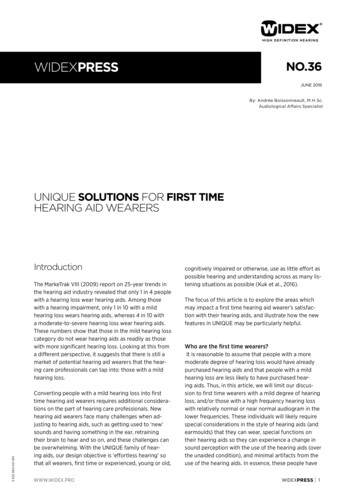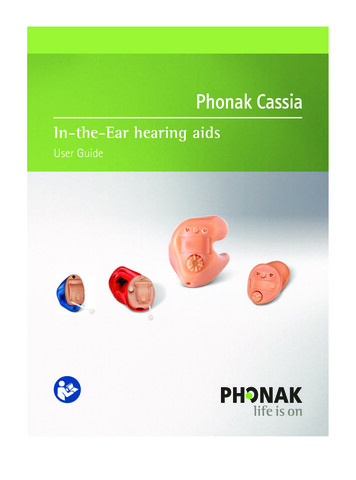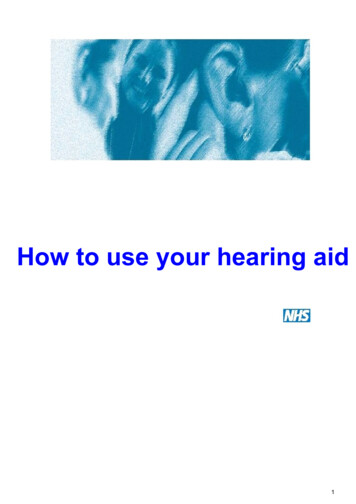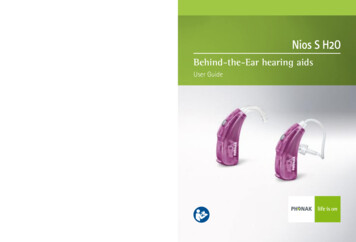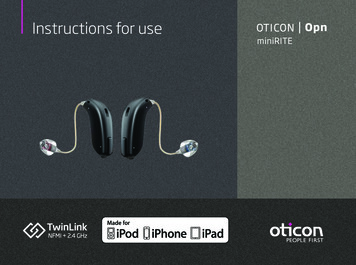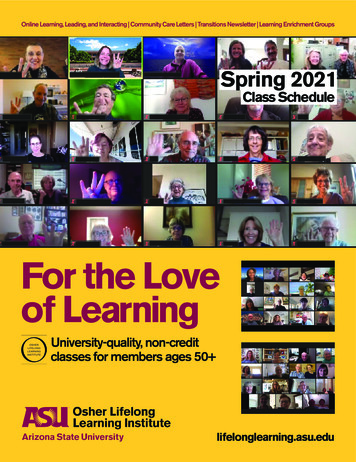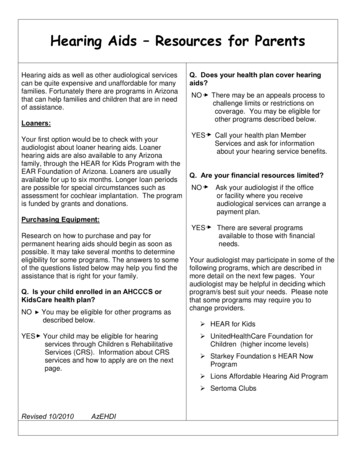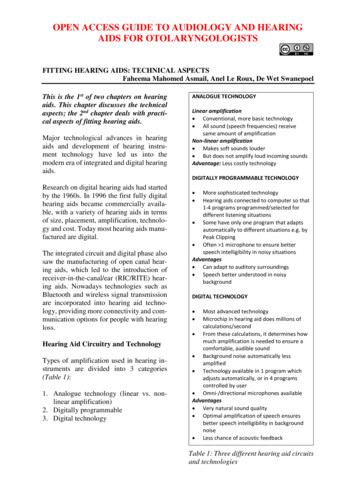
Transcription
ASU Speech & Hearing Clinic Hearing Aid ServicesThank you for considering the ASU Speech & Hearing Clinic for your hearing healthcareneeds. The purchase and fitting of hearing instruments is a very important process andone that involves so much more than simply purchasing a quality product. Hearing aidsare medical devices and not a retail “one-size fits all” type of product. An essentialcomponent to every successful fitting is the skill and expertise of the audiologist inselecting an appropriate hearing instrument for your individual needs and thenappropriately fitting the hearing aid using advanced measurement and fitting techniquesdesigned to verify that the hearing aid is programmed correctly for your hearing loss andneeds. The quality of the fitting is paramount to your success with a hearing aid. A 10year old hearing aid fit well following best practice guidelines will outperform a high-endexpensive digital hearing aid that is fit using manufacturer first-fit algorithms withoutappropriate real ear verification measurements. Therefore, before deciding where to befit with a hearing aid, consider the quality of service as well as the quality of the product.While the majority of hearing aids currently available on the market are high qualityinstruments and provide significant benefits to those with hearing loss, not all hearinginstruments are created equal. Hearing aid technology ranges from very basic digitalcircuits to very sophisticated digital hearing aid circuits. The appropriateness of circuitrytype as well as the selection of hearing aid style and other options depends on a numberof audiological and non-audiological factors. In general, hearing aids are capable ofamplifying sounds as needed to compensate for a given individual’s hearing loss and cansubstantially improve an individual’s ability to hear and understand speech in a variety ofcommunication situations. However, it is important to realize that these devices do notrestore hearing to normal, do not eliminate all unwanted sounds, and do not enable theuser to understand conversational speech perfectly in every situation, particularly in thosesituations made more difficult due to noise, distance and reverberation. The type ofhearing aid recommended and the amount of benefit one receives from hearing aids is notthe same for all users and is dependent on a number of factors including:1. the severity and type of hearing loss2. the ability to utilize residual hearing to understand speech3. the appropriateness of hearing aid characteristics and how well the hearing aid isprogrammed for the individual4. the listening demands in a variety of circumstances5. the user’s expectations and desires for improvement6. the user’s ability and determination to adjust to hearing aid useRemember, no two hearing impaired people are alike. Professional guidance from ournationally recognized and state-licensed audiologists is essential in selecting which
hearing aid will best meet your needs. The ASU Speech & Hearing Clinic provides thefull range of comprehensive hearing aid services needed to ensure a successful outcomeincluding an audiological evaluation, Communication Needs Assessment, hearing aidprogramming and fitting, hearing aid orientation and follow-up. Proper functioning andfitting of existing hearing aids is determined through coupler and real-ear electroacousticmeasurements. If necessary, repair and/or reprogramming can be performed to ensurethat you are receiving maximum benefit from your existing hearing aids. Our clinic’saudiologists remain current with the relevant research in order to provide state-of-art andevidence-based hearing healthcare diagnostics and treatment to our patients whiletraining the next generation of audiologists.UNBUNDLED PRICING AFFORDABLE AND HIGH QUALITY HEARINGHEALTH CAREThe ASU Speech & Hearing Clinic uses an unbundled pricing model that separates theprofessional fees for assessment and the fitting and follow-up procedures from theproducts that are selected and fitted. This leads to more affordable hearing care becauseyou pay less upfront and then pay only for those services that you need after the initialfitting and adjustment period. Traditionally, the cost of the services for the fitting andfollow-up is bundled into the cost of the hearing aids. With the traditional bundledapproach, the patient pays upfront for the purchase of the hearing aids as well as the feesfor services to fit the instruments and for follow-up appointments for a specified timeperiod. With a bundled model you pay thousands of dollars upfront for services that youmay never use and you may or may not receive the same type or level of servicesdepending upon where the instruments are fitted; however, because the cost is notitemized you don’t know what or how much you are paying for the aids versus otherservices.At the ASU Speech & Hearing Clinic, regardless of which hearing aid is chosen, thepatient pays the wholesale cost for the hearing aid in addition to the professional servicefees to properly fit the hearing aids, following best practice guidelines, and follow-up forthe evaluation and adjustment period of 45-days. The cost of the professional fitting feesis the same regardless of the hearing aid make/model dispensed and the cost for thoseservices is completely transparent, that is, itemized so you know what you paid for. Allfollow-up services for maintenance and follow-up are charged as the services arerendered and needed by the patient. With an unbundled approach, patients with existinghearing aids purchased elsewhere may choose to have their hearing aids reprogrammed atthe ASU Speech & Hearing Clinic and will pay for the procedures needed to refit themproperly. Below compares the bundled versus unbundled approach to fitting hearingaids:Bundled Pricing ModelAdvantagesDisadvantages
Familiar pricing structureNo charge for routine maintenance andfollow-up (length of no charge perioddepends on the clinic)Upfront, initial price is higherYour contract for services is with a specificclinicIf you do not follow-up regularly with yourdispenser you have paid for services you neverreceivedYou don’t know what you are paying for andmay not get the services needed to properly fitthe hearing aidsIf you travel or move away the services youpaid for upfront will not transferDue to high upfront cost, users wait years toupgrade to newer technologyConsumer incorrectly perceives that they arebuying just a hearing aid and devalue theprofessional services integral to a successfulfittingSales-model: the dispenser may use hard salestactics and push high-end technology to drivehigher profitsUnbundled Pricing ModelAdvantagesDisadvantagesLow upfront purchase price of hearingLess familiar pricing structureaids and initial fitting/follow-up services.Fair, transparent pricing of hearing aids ator close to single unit wholesale priceYou can seek quality audiological careBecause patients pay for maintenance andwherever you are; your contract is notfollow-up services they may not reliably returnwith a specific clinicas recommended for servicesYou pay only for appointments andSome patients may dislike the “pay-as-you-go”services that are needed and when they approach where they are charged for everyare neededvisit and procedure. For these patients, allinclusive maintenance and follow-up plans areprovided as alternativeWith a lower initial price, users canchoose when they want to upgrade theirhearing aidsPricing is completely transparent; youknow exactly what service you arereceiving and paying for
Anyone, regardless of where theypurchased their hearing aids, can be fit orrefit using best practiceEstablishes value for the professionalservices and expertise of the audiologistMedical model: the clinic focuses onproviding high quality fitting and followup services and not on selling hearingaids.Below is a description of the hearing aid services provided at the ASU Speech & HearingClinic, outlining the steps involved in obtaining a hearing aid from the initial hearingevaluation to successful hearing aid use. The appropriate provision of amplification is amulti-stage process that follows best practice protocols. There are 6 basic steps and allare integral to a successful outcome: 1) Comprehensive Audiological Evaluation, 2)Communication Needs Assessment, 3) Pre-fit programming and verification measures, 4)Initial hearing aid fitting & verification of targets, 5) Post-fit management and 6)Validation measures (long-term outcomes). Comprehensive Audiological Evaluation: The first step in obtaining a hearing aid isa comprehensive hearing test or audiological evaluation. The hearing evaluation at ASUtakes approximately 1 ½ hours and includes a detailed history including measures of selfreported handicap and disability, immittance testing, air and bone conduction audiometry,and comprehensive speech audiometry. Other tests, such as otoacoustic emissions, areincluded as deemed medically necessary by the test results and/or the patient’s history.The results of this evaluation enable us to determine the type and severity of the hearingloss, the necessity for medical consultation, and whether or not hearing aid use is anappropriate treatment option. Based upon the test results, the patient’s candidacy for oneor two hearing aids can be determined and it is recommended that the patient return for amore in-depth Communication Needs Assessment for additional testing to determine thespecific hearing aid recommendation by matching the best technology to the patient’sneeds. During the evaluation, an ASU clinical supervisor (state-licensed and certified bythe American Speech-Language and Hearing Association), together with a Doctor ofAudiology student clinician, will complete the testing, explain your test results anddiscuss your needs and desires for hearing improvement. The fee for the comprehensiveaudiological evaluation is 180.00. Communication Needs Assessment: The next step in obtaining a hearing aid is aconsultation with the audiologist to select the best hearing aid for your particular hearingloss and communication needs. During this appointment, additional testing, notcompleted during the audiological evaluation, will be completed that will help to identifyareas of difficulty and need. Self-report questionnaires provide information about your
perception of activity limitations (disability) and participation restrictions (handicap) aswell as expectations and preferences. If you have existing hearing aids, they will also betested at this time to determine their function and appropriateness. It may be the case thatexisting hearing aids require refitting to improve your performance rather than thepurchase of new hearing aids. After a thorough review of all audiological and nonaudiological needs, we will discuss with you our professional recommendationsregarding your potential for benefit from hearing aid use and your desires and needs forhearing improvement. Additionally, the appropriateness of different hearing aid circuitry,hearing aid styles, and the need for different features in a hearing aid will be determined.At the ASU Speech & Hearing Clinic, we use a wide variety of advanced technologyproducts from many major manufacturers including Widex, Oticon, Phonak, GNResound,Sonic Innovations, Siemens, Unitron, and Starkey. If additional assistive technology orservices are deemed necessary to help you with full accommodation of your hearing lossat home, work, or school they may be recommended at this time or a separate HearingAssistive Technology (HAT) assessment may be recommended. It is very helpful tohave a family member or friend present with you at this time, and throughout the processof obtaining hearing aids, so that he/she can provide support and assistance as you (oryour child) learn to use hearing aids. The fee for the Communication Needs Assessmentis 135.00.At the end of the Communication Needs Assessment, a specific hearing aidrecommendation will be provided. You may choose to purchase the recommendedhearing aid(s) anywhere. If you elect to purchase the recommended hearing aid(s) fromthe ASU Speech & Hearing Clinic, a price quote will be prepared for you and earimpressions will be taken as well as an electroacoustic measurement called the RECD(real-ear-to-coupler difference). The additional fees for the ear impressions and theRECD testing will apply as well as the fee for custom earmolds and the payment for theseitems and services is due at this appointment. Please note: the professional servicesprovided and the cost of the custom earmolds are non-refundable should I decide toreturn any hearing aids subsequently fitted.Once the decision is made to obtain hearing aids, an impression of the ear is taken so thatthe hearing aid or earmold can be shaped to fit properly in the ear canal. We take greatcare in obtaining a good ear impression through the use of an open-jaw technique and theuse of high viscosity impression material. The use of this technique has significantlyreduced the need for remakes due to a poorly fitting shell or earmold. The fee for theearmold impression and any custom earmolds is due at this appointment. Lastly, a real earmeasurement (real-ear-to-coupler difference) is taken to determine the acoustic size ofyour ear canal. The RECD is an important measurement to correctly convert yourhearing thresholds into accurate hearing aid amplification targets. Hearing Aid Pre-Fitting: Following best practice guidelines, before you come in tobe fit with your hearing aids, our audiologists and student clinicians complete a variety of
tests important for quality assurance and electroacoustic measurements to ensure thehearing aids are properly programmed to your hearing aid prescription. Prior to yourarrival, we will have performed an electroacoustic analysis on the hearing aids to ensureproper functioning and adherence to the manufacturer’s specifications. This analysis alsoincludes a test of processing time delay and phase measurements as well as a verificationof directional microphone performance. Additionally, prior to fitting the hearing aids toyou, your hearing aids will have been pre-programmed to an appropriate prescriptivetarget using electroacoustic measurements to verify that all hearing aid parameters havebeen set properly. This programming includes all the hearing aid programs including thetelecoil program, which is often overlooked." Hearing Aid Fitting and Follow-up: Our comprehensive hearing aid fitting protocolis carefully designed and implemented to ensure a satisfactory hearing aid fitting.Approximately two weeks after the hearing aids and/or earmolds are ordered, you willreturn to the ASU Hearing Clinic for evaluation and fitting of the hearing aids. Duringthe actual fitting appointment, we will further verify that the hearing aids have been setproperly for your hearing loss by measuring the sound pressure delivered to your earcanal while the hearing aids are worn (real ear probe microphone measurements). Thistest will ensure that soft, average and loud speech inputs are appropriately amplifiedwithin your range of hearing and that very loud environmental inputs never exceed yourmaximum discomfort levels. Hearing aid programming adjustments are made, asnecessary, based on these results and your listening preferences.Thorough hearing aid counseling and orientation will be provided to teach you how touse and care for your new hearing aids. During the appointment you will practiceoperating the aids to assure that you will be able to handle the aids independently athome. We will also practice telephone use and the operation of your hearing aids’telecoil. Finally, the audiologist will review proper expectations and suggestions to assistyou during the adjustment period. A packet of useful information will be provided foryou to take home covering the importance of audiological rehabilitation. Participation inour group audiological Rehabilitation program called Living WELL with Hearing Losswill be recommended and encouraged.During the 45-day evaluation & adjustment period, it is important that you return tothe ASU Hearing Clinic for appropriate follow-up appointments to assure that the hearingaids are adjusted properly. We would like to see you for follow-up appointments at leastas often as listed below: One, two weeks, and four weeks after the initial hearing aid fitting:o During these appointments, aided soundfield testing will be completed tomeasure maximum aided audibility as well as speech recognition in quietand in noise; hearing aid reprogramming will be completed as indicated. Near the end of the 45-day evaluation & adjustment period—six weeks postfitting:
o By the end of the adjustment period, adaptation to the new hearing aidsshould be nearly complete. At this time outcome measures will be used tofurther validate the success of the fitting and to determine the degree ofhearing aid benefit. Post-Fitting Management:After the initial hearing aid fitting and 45-day evaluation & adjustment period has ended,you may choose how you will pay for additional follow-up services. Option 1) Pay-AsYou-Go: this option allows you to pay for only those follow-up services that you use. Perour unbundled pricing structure, appointments falling outside the evaluation &adjustment period will be billed for services rendered during each appointment. At aminimum, each appointment will have a 45.00 office visit fee and the charges for anyadditional tests and services needed during the visit will apply. Option 1 is recommendedfor patients who require only routine follow-up or only reside in the Phoenix area part ofthe year. Option 2) All-Inclusive Patient Comprehensive Care Plan: this option allowsyou to pre-pay for all post-fitting services either annually (PCCP-I) or for a period ofthree years (PCCP-II). While covered under the PCCP, all appointments through theASU Speech & Hearing Clinic for follow-up and maintenance of your hearing aids areincluded as well as plan-specific discounts for accessories, new earmolds, etc. Additionalfees to repair your hearing aids if they are not in-warranty with the manufacturer, willapply.RECOMMENDED FOLLOW-UP: Adhering to the recommended schedule of routinefollow-up appointments is important to helping you be successful with your hearing aidsand to receive the proper maintenance. Regular follow-up for hearing aids isrecommended approximately every three months based on the following schedule ofservices. Please note, these are examples; your audiologist will determine what is neededduring each follow-up appointment.3-month follow-up appointmentHearing aid visual and listening inspectionHearing aid cleaningProgramming adjustments, if needed6-month follow-up appointmentHearing aid visual and listening inspectionElectroacoustic analysis to determine functioningHearing aid cleaningSmall parts replacement: mic screens, tone hooks, tubing, etc., as neededProgramming adjustments, if needed9-month follow-up appointmentHearing aid visual and listening inspectionHearing aid cleaningProgramming adjustments, if needed
12-month annual check-upHearing re-evaluationHearing aid visual and listening inspectionElectroacoustic analysis to determine functioningHearing aid cleaningSmall parts replacement: mic screens, tone hooks, tubing, etc., as neededProgramming adjustments, if neededAnnual manufacturer overhaul as needed Living WELL with Hearing Loss Audiological Rehabilitation Groups:Participation in an audiological rehabilitation group is encouraged to help you achieve themost benefit from your hearing aids. These 7-week classes meet once a week for twohours. More information regarding the Living with Hearing Loss group is available onour website.
At the ASU Speech & Hearing Clinic, regardless of which hearing aid is chosen, the patient pays the wholesale cost for the hearing aid in addition to the professional service fees to properly fit the hearing aids, following best practice guidelines, and follow-up for the evaluation and adjustment period of 45-days.
